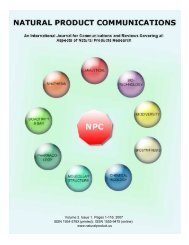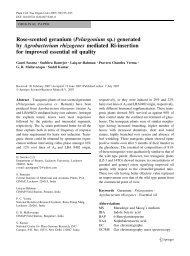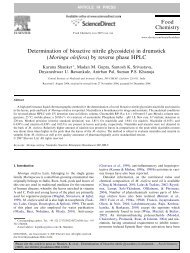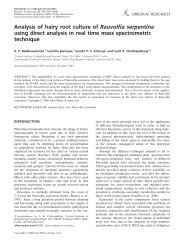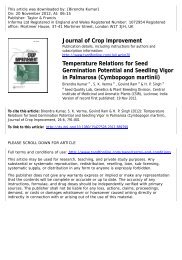Rai A, Smitha SS, Singh AK, Shanker K, Nagegowda ... - CIMAP Staff
Rai A, Smitha SS, Singh AK, Shanker K, Nagegowda ... - CIMAP Staff
Rai A, Smitha SS, Singh AK, Shanker K, Nagegowda ... - CIMAP Staff
- No tags were found...
You also want an ePaper? Increase the reach of your titles
YUMPU automatically turns print PDFs into web optimized ePapers that Google loves.
<strong>Rai</strong> et al. • C. roseus Geranyl Diphosphate Synthases Page 3 of 20isoprenoid biosynthesis, respectively. This is the first report ofcharacterization of both heteromeric and homomeric GPPSenzymes from the same plant.RESULTS AND DISCU<strong>SS</strong>IONIsolation of C. roseus cDNAs Encoding GPP SynthasesIn plants, the enzyme responsible for GPP formation isknown to exist either as homomeric or as heteromericforms (Burke et al., 1999; Bouvier et al., 2000; Burke andCroteau, 2002a, 2002b; Tholl et al., 2004; Schmidt andGershenzon, 2007; van Schie et al., 2007; Schmidt andGershenzon, 2008; Orlova et al., 2009; Chang et al., 2010).To identify and investigate the role of GPPS in C. roseus MIAbiosynthesis, a search for potential GPPS sequences wascarried out initially by blast search analysis against the NCBI(www.ncbi.nlm.nih.gov/) database and later against therecently released MPGR (http://medicinalplantgenomics.msu.edu) database. A search for potential gene encodingGPPS.LSU yielded four potential GGPPSs. The first sequence,named CrGGPPS1 (for C. roseus GGPPS), is represented bya sequence submitted in GenBank (GGPPS; JF896104) andtwo contigs annotated as GGPPS in MPGR (cra_locus_1452_iso_1_len_1087_ver_3 and cra_locus_1452_iso_2_len_1656_ver_3). This gene has been recently shown by geneticcomplementation as a functional GGPPS (Thabet et al.,2012). The second sequence referred to as CrGGPPS2is represented by three contigs (cra_locus_6993_iso_3_len_1491_ver_3, cra_locus_6993_iso_2_len_1416_ver_3, andcra_locus_6993_iso_1_len_1405_ver_3) with an annotationas GGPPS. The third and the fourth sequences, namedCrGGPPS3 and CrGGPPS4, are represented by single contigscra_locus_6454_iso_5_len_849_ver_3 and cra_locus_12153_iso_7_len_1107_ver_3, respectively. Of these CrGGPPS1,CrGGPPS2, and CrGGPPS4 encoded full-length open readingframes, whereas CrGGPPS3 was missing the 3′ region, whichwas obtained by rapid amplification of cDNA ends (RACE).The ORFs with 1656 bp, 1491 bp, 1144 bp, and 1107 bp ofCrGGPPS1-, CrGGPPS2-, CrGGPPS3-, and CrGPPS4-encodedproteins of 383 aa (M r , 41 599), 371 aa (M r , 40 156), 306 aa(M r , 33 141), and 343 aa (M r , 37 645), respectively. A BLASTPanalysis of CrGGPPSs against the NCBI database (www.ncbi.nlm.nih.gov/) revealed that CrGGPPS1, CrGGPPS2,CrGGPPS3, and CrGGPPS4 showed highest amino acidsequence similarity to the LSU from A. majus (Tholl et al.,2004), GGPPSs from Nicotiana tabacum (Orlova et al., 2009),Hevea brasiliensis (Takaya et al., 2003), Corylus avellana(Wang et al., 2010), respectively. Further, pairwise sequencepercent identity of CrGGPPSs and other plant GGPPSs/LSUs(Table 1) revealed that, among four CrGGPPSs, CrGGPPS1showed the highest sequence identity of (70–74%) to LSUsof heteromeric GPPSs from A. majus (Tholl et al., 2004),H. lupulus (Wang and Dixon, 2009), and M. piperita (Burkeet al., 1999) (Figure 2A). Further, MPGR blast search withknown <strong>SS</strong>U-I and <strong>SS</strong>U-II sequences yielded a partial lengthsequence (referred to as CrGPPS.<strong>SS</strong>U) of 763 bp (PUT-165a-Catharanthus_roseus-1810024) corresponding to <strong>SS</strong>U-Iclass (Wang and Dixon, 2009). However, a comprehensivesearch for sequences similar to <strong>SS</strong>U-II class did not yield anysequences, indicating that C. roseus has only <strong>SS</strong>U-I class. Themissing 3′-translated region of CrGPPS.<strong>SS</strong>U was recoveredby 3′ RACE. The full-length CrGPPS.<strong>SS</strong>U encoded a 299-aa (M r , 32 376) protein. Amino acid sequence comparisonexhibited homology of CrGPPS.<strong>SS</strong>U to other plant GPPS.<strong>SS</strong>Us and showed 57%, 54%, and 51% identities to <strong>SS</strong>Usof A. majus (Tholl et al., 2004), M. piperita (Burke et al.,1999), and H. lupulus (Wang and Dixon, 2009), respectively(Figure 2B). This CrGPPS.<strong>SS</strong>U was represented by five contigsin the MPGR database.A homology search to isolate the homomeric GPPS resultedin a full-length gene sequence submitted in NCBI as GPS(EU622902), which is represented by seven contigs in MPGR.This gene is hereafter referred to as CrGPPS. The full-lengthCrGPPS cDNA (1263 bp) encoded a protein of 420 aa (M r ,46 329). The sequence comparison of CrGPPS exhibited thehighest similarity to other characterized angiosperm or gymnospermhomomeric GPPSs with 76% identity to L. esculentum,74% identity to Q. robur GPPS (Schmidt and Gershenzon,2008), and 67% and 65% identities to GPPS from A. thaliana(Bouvier et al., 2000; van Schie et al., 2007) and P. abies(Schmidt and Gershenzon, 2008), respectively (Figure 3). Thealignment of sequences of different homomeric and heteromericenzymes showed the presence of two highly conservedaspartate-rich regions, designated as the first aspartate-richmotif (FARM, DDX (2–4) D) and second aspartate-rich motif(SARM, DDXXD) (where D indicates Asp, X indicates any residue)essential for catalytic function and substrate binding(Koyama et al., 1996; Wang and Ohnuma, 2000) whereasCrGPPS.<strong>SS</strong>U lacks both DD(X n )D motifs (Tholl et al., 2004).Further comparisons of sequences highlight the presence oftwo conserved CxxxC motifs (where ‘x’ can be alanine, leucine,isoleucine, valine, glycine, or serine) in CrGPPS.<strong>SS</strong>U similarlyTable 1. Sequence Relatedness of CrGGPPS and Plant GGPPS/LSUProteins.(1) (2) (3) (4) (5) (6) (7) (8) (9) (10)(1) CrGGPPS1 100(2) AmGPPS.LSU 74 100(3) HlGPPS.LSU 70 69 100(4) MpGPPS.LSU 69 68 69 100(5) CrGGPPS2 65 64 68 62 100(6) NtGGPPS1 63 57 68 63 74 100(7) CrGGPPS4 62 59 60 58 60 57 100(8) AtGGPPS6 58 58 60 57 58 56 54 100(9) NtGGPPS2 55 57 57 56 57 55 52 52 100(10) CrGGPPS3 46 44 42 42 52 39 52 43 39 100Downloaded from http://mplant.oxfordjournals.org/ at Central Inst. Of Medicinal & Aromatic Plants (Cimap) on July 17, 2013




